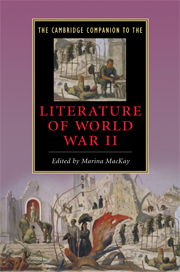9 - The Italian war
from Part II - Global perspectives
Published online by Cambridge University Press: 28 May 2009
Summary
In standard histories, the Second World War is dated from 1939 to 1945, from Germany's invasion of Poland to surrender in Berlin and atom bombs over Hiroshima and Nagasaki. But global chronologies can obscure local histories, and often a simple adjustment of dates is useful as a first step towards understanding the particularities of a single nation's experience of the war and the literary representations that came out of it. The chronology of Italy's Second World War was complex and fragmented, producing distinct layers of memory and representation (and, indeed, silence and oblivion) within its war literature. So, if we were to start with a bald chronological adjustment to reflect this complexity, we should first replace 1939-45 with something like: 1940-43/45. Mussolini's regime - in power since 1922 (and in full dictatorial control since 1926) - had been the founding model of modern, Fascist totalitarianism and a key inspiration for Hitler's Nazi movement and rise to power. By 1939, Fascist Italy had long been talking of war, militarizing its youth, and fighting colonial or proxy wars (Ethiopia, Spain). It had formally allied itself to Nazi Germany in the Axis Pact of Steel in May 1939. However, when war was declared in September, Italy's armed forces were, in reality, drastically underprepared and ill equipped and could not hope to respect the Axis pact. Only when the astonishing Nazi sweep across Europe seemed to herald victory did Mussolini hastily join battle, in June 1940, invading southern France. In the following three years, Italy fought in several European and African theatres (Greece, Ethiopia, Egypt, Libya) and in the doomed Axis advance into Russia of 1941-43, and administered various occupied territories (parts of the Balkans, France); but in almost every arena, they were dogged by failure, leading to rescue or retreat.
- Type
- Chapter
- Information
- The Cambridge Companion to the Literature of World War II , pp. 123 - 136Publisher: Cambridge University PressPrint publication year: 2009
- 2
- Cited by

